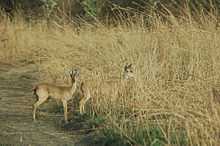Oribi
| Oribi | |
|---|---|
 | |
| Oribis at W National Park, Niger Section | |
| Conservation status | |
| Scientific classification | |
| Kingdom: | Animalia |
| Phylum: | Chordata |
| Class: | Mammalia |
| Order: | Artiodactyla |
| Family: | Bovidae |
| Genus: | Ourebia |
| Species: | O. ourebi |
| Binomial name | |
| Ourebia ourebi Zimmermann, 1782 | |
| Subspecies | |
|
Ourebia ourebi aequatoria | |
 | |
| Geographic range | |
Oribi (Ourebia ourebi, known as oorbietjie in Afrikaans) are graceful slender-legged, long-necked small antelope found in grassland almost throughout sub-Saharan Africa.
Description
Oribi grow to around 92–110 cm (36 to 43 in) in length, with a shoulder height of 50–66 cm (20 to 26 in) and weigh an average of 12–22 kg (26 to 49 lb). They can run at speeds of up to 40–50 km/h (25–31 mph). In captivity, they have lifespans of up to 14 years.
The back and upper chest is yellow to orange-brown. The chin, throat, chest, belly, and rump are white. The tail is short and bushy, the upper side black or dark brown, and the under surface white. The white, crescent-shaped band of fur above the eye helps to distinguish this species from other similar-looking antelope. Below each ear is a large, round, black, glandular patch, the nostrils are prominently red, and on the sides of the face are vertical creases that house the preorbital glands. These glands produce an odorous secretion used to mark the oribi's territory. Only males grow horns, which are slender and upright, ridged to about halfway up, the ends being smooth and pointed, with some of length 19 cm (7.5 in) being recorded.
Distribution and habitat
Oribi are found in most countries throughout sub-Saharan Africa, ranging from Senegal to west and central Ethiopia and southern Somalia, southward into eastern Kenya, across into north Botswana, Uganda, and Angola, with patchy and discontinuous distribution through Mozambique, Zimbabwe and into central and eastern South Africa.
They typically inhabit open grasslands or thinly bushed country, preferring habitats with short grasses on which to graze, interspersed with tall grasses which provide cover from predators and the elements. Oribi are highly water-dependent and tend to avoid steep slopes.
Reproduction
During the breeding season, August to December, the male will mate with all the females which share his territory. Usually, only one or two females are present in each territory. Following a gestation period of six to seven months, a single offspring is born. For the first eight to 10 weeks the female oribi hides her young in thick grass, where it will lie motionless if approached. The mother returns periodically to suckle her offspring. Young are weaned at about four to five months. Females reach sexual maturity at 10 months, males at 14 months.
Diet
Primarily grazers, oribi prefer to eat short grasses, but will browse on leaves, foliage and young shoots during the dry season. They are often seen in burnt areas after veld fires, returning to the area to eat the fresh grass shoots. The oribi also use mineral licks to supplement their diets.
Predators
Oribi fall prey to numerous animals, including lions, leopards, caracals, hyenas, African wild dogs, jackals, crocodiles and pythons. Young are also taken by eagles, genets and other small carnivores.
Behaviour
Oribi are found on their own, in pairs, or in small groups of one male with two or more females. Resting during the heat of the day, oribi are most active in the morning, late afternoon and evening. When alarmed, they produce a shrill whistle. Often, they do not attempt to flee until an intruder is within a few meters, remaining motionless in the grass, relying on camouflage. If threatened, they gallop away, bounding stiff-legged into the air every few strides; a behaviour known as stotting.
Threats and conservation
Oribi populations in many areas are threatened by human activities, such as:
- Habitat destruction - Grasslands are lost to expanding settlement, commercial forestry, intensive commercial farming, grassland degradation due to overstocking, poor use of fire, erosion and mining.
- Illegal hunting - Trapping with snares and hunting with dogs are serious threats, and has led to the demise of many oribi populations in South Africa.
- Inappropriate management - In many areas where oribi are present, farm management practices (impenetrable fences, poor burning practices, poor veld management, domestic dogs) do not allow oribi to coexist. Sport hunting of oribi at unsustainable levels also threaten their survival.
Oribi occur in several protected areas and are the subject of a WWF Species Project. This project aims to track captive-bred oribi after their release into appropriate habitat to research their home ranges and habitat preferences. The long-term aim of the project is to establish viable wild populations from captive-bred stock.
Subspecies
These subspecies have been described:
- Ourebia ourebi aequatoria (Uganda)
- O. o. cottoni (Tanzania)
- O. o. dorcas (Chad)
- O. o. gallarum (Central Ethiopia)
- O. o. goslingi (North Democratic Republic of Congo)
- O. o. haggardi (Northern Kenya)
- O. o. hastata (Zaire, Malawi, Zimbabwe)
- O. o. kenyae (Kenya)
- O. o. montana (Sudan to west Ethiopia)
- O. o. ourebi (South Africa)
- O. o. quadriscopa (Senegal to Nigeria)
- O. o. rutila (Angola)
- O. o. ugandae (Uganda)
Two of these subspecies are listed on the IUCN Red List: Haggard's oribi (O. o. haggardi) is classified as Vulnerable (Vu C1) and the Kenya oribi (O. o. kenyae) is classified as Extinct.
References
- ↑ IUCN SSC Antelope Specialist Group (2008). Ourebia ourebi. In: IUCN 2008. IUCN Red List of Threatened Species. Retrieved 29 March 2009. Database entry includes a brief justification of why this species is of least concern.
Sources
- ARKive - images and movies of the oribi (Ourebia ourebi)
- EcoTravel guide to the oribi
- Ezemvelo KZN Wildlife
- Webkenya - Wildlife in Kenya
